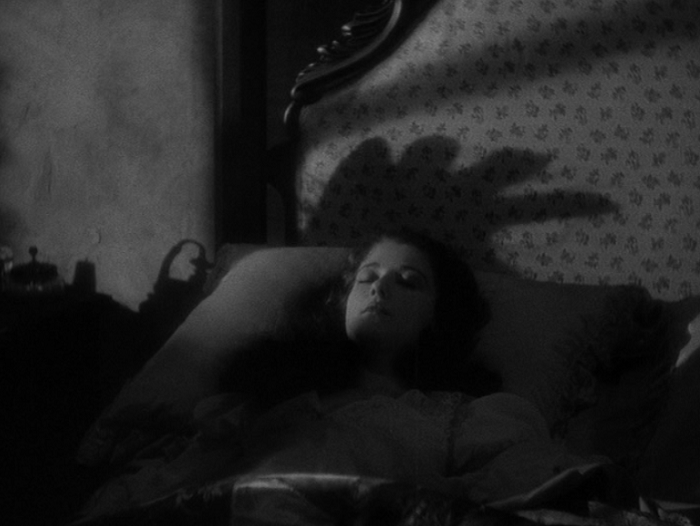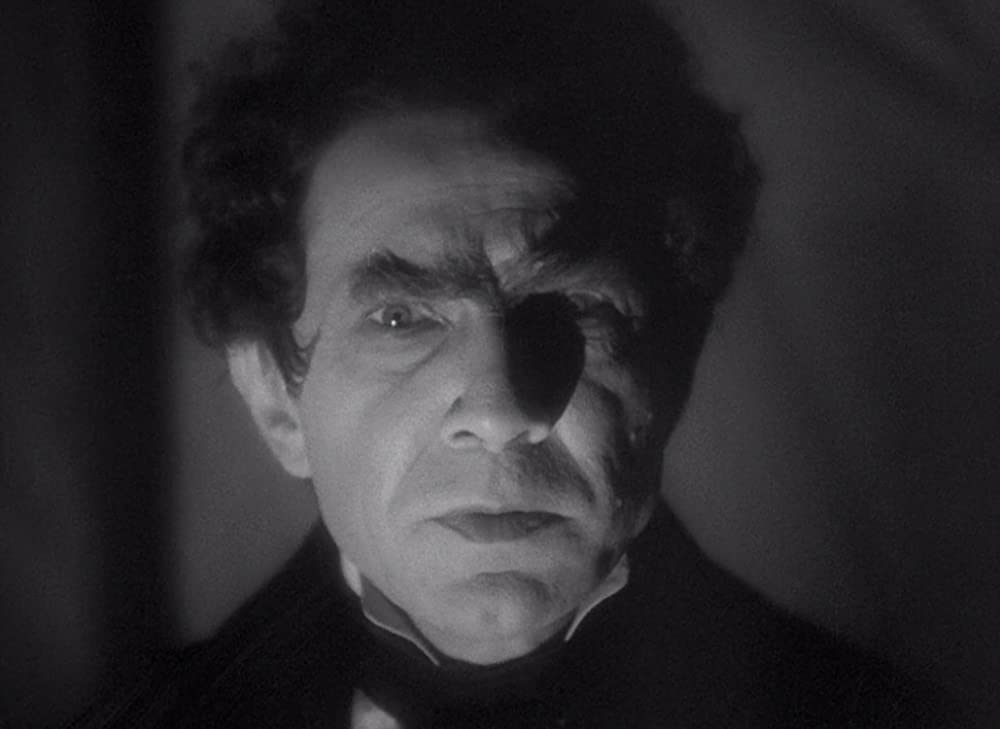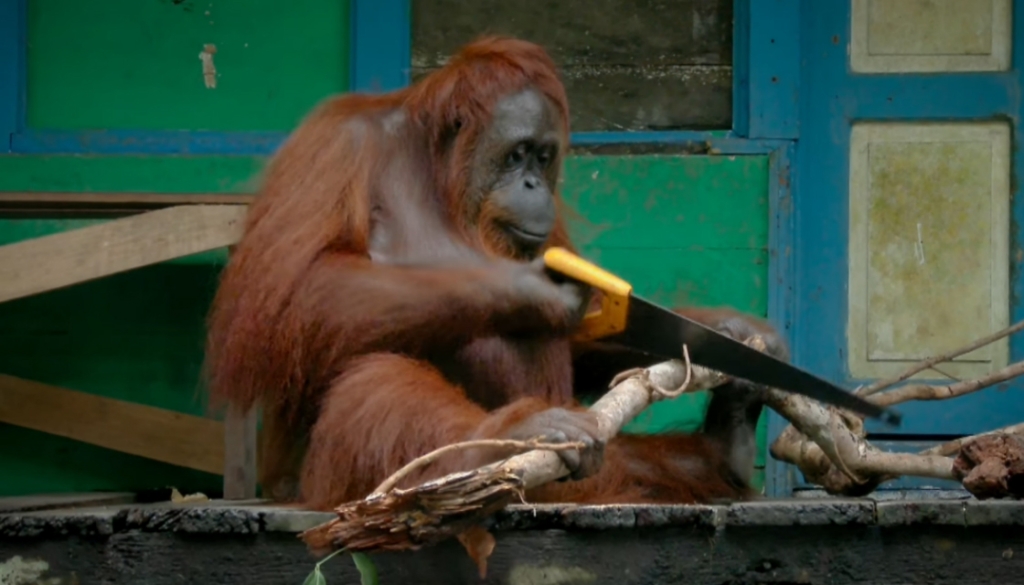
I write about monster apes as a crucial part of the monster enterprise, but the contradiction at the heart of that is that apes are not monsters—they are us. Once upon a time, pointing out the striking similarities between humans and the great apes was a shocking but intriguing idea, a source of merriment and thought experiments…and then it simply became incontrovertible that humans aren’t just similar to the great apes. To some people, this realization has been a source of enlightenment, a recognition of the interconnected nature of all living things on this planet. To others, however, from the earliest days of evolutionary theory to now, it only creates this grotesque mirror, a backwards mockery of human exceptionalism and civilization in animal form. Those two approaches is where the central complication of “apes-as-monster” comes together: we see ourselves in these animals, and sometimes that makes us want to sympathize with them (maybe that’s why ape movies have their own distinct following), and other times, it makes us fear them. In both cases, it’s because of what their very existence says about us.
Carl Linnaeus was the first to suggest that humans were directly related to other primates in the eighteenth century, and as great apes like chimpanzees and orangutans became more well-known in the western world in the subsequent years, the connection was increasingly a central fascination among fantasists. While many early depictions of apes in fiction were meant to play their relationship with humanity for satire, among the most famous early stories about an ape was Edgar Allan Poe’s 1841 short story “The Murders in the Rue Morgue.” The story is probably more well-known as the first true detective story, portraying a genius private citizen using deductive reasoning (Poe called it “ratiocination”) to solve a seemingly impossible crime, much to the astonishment of the bumbling local police—but it is also a likely inspiration for the apes-as-monster stories that would follow, the one that showed how an ape could be a figure of fear. Sure, it’s “only” an orangutan—normal-sized, no kung-fu skills—but to the people reading it in 1841, an orangutan was something unusual, something they’d probably never seen before (even if they read about it), something that didn’t sound real. In the twentieth century, ape fiction was still trying to maintain that mysterious and unsettling air, but since we knew more about them then, they started exaggerating them in different ways. In any case, Poe used the limited public exposure of apes like orangutans to make something memorably gruesome.

There really isn’t much of a plot in “Rue Morgue”—in some ways it’s just as much a gimmick as a story, albeit an inventive one. After using several paragraphs to explain how analytical reasoning works, the unnamed narrator tells the tale of how he came to live with eccentric smart guy C. Auguste Dupin (who would appear in other Poe mystery stories) in Paris, spending all their time together either in their big house or walking around together at night arm-in-arm. Absolutely no subtext to that relationship at all, no sir. For fun, I guess, Dupin decides to investigate a horrific double murder after reading about its many unusual details in the newspaper—a distressingly casual approach to true crime stories has existed for centuries, obviously. A young woman and her mother living in the street of Rue Morgue were heard screaming in their room, but by the time others responded, the daughter was found strangled and shoved into the chimney, while the mother was thrown out the window and more or less decapitated. You can see why Dupin thought it sounded like a fun caper to crack! The whole “mystery” revolves around the seeming impossibility of the crime—the door to their room was locked, the window was out of the way, and it didn’t seem likely that one person could cram a body into the chimney. To add some levity, the witnesses who were trying to break down the door while the crime occurred swear that they heard two voices, one French and the other speaking a language that each witness claims was one of several other languages, despite them admitting that they don’t actually know any of those languages. Dupin somehow cons his way into the crime scene, and after examining the location and finding even more evidence (including an untouched sum of money, and a sample of strange hair), he seemingly solves the case immediately, but takes his time explaining it.
As a basal detective story, “Rue Morgue” doesn’t supply a cast of suspects for readers to guess on, but rather gradually builds to what is ultimately a rather ridiculous solution to the central mystery. Of course, the only one who could have committed the murders was an orangutan, who could climb up the lightning rod near the window to get in and out of the room. Dupin’s idea is confirmed after he puts out a classified ad asking if anyone is missing an orangutan, which attracts the attention of a sailor, who tells the whole story of his pet ape escaping while holding a razor and him witnessing what happened (his was the French voice heard by the witnesses.) Apparently, since the sailor was not directly involved in the crime, and there weren’t any laws in the books pertaining to orangutans yet, it is basically a perpetrator-less crime—which, I don’t know, I think people these days are given more responsibility for their razor-wielding apes.

This story is a bit over-the-top, less a proper mystery and more one of Poe’s trademark horror stories with a detective framework, but one can’t argue that the imagery in the story isn’t memorable. The full, terrible possibility of an ape on the loose is portrayed, but far more than just being a wild animal rampage, the distorted mirror image quality of the orangutan makes it all the more disturbing. As we learn from the sailor, the ape was imitating shaving before running off, which was why it was carrying a razor in the first place, and in his description of the murders, he says that it was then mimicking a barber—this was an animal trying to be like a human, and out of misunderstanding and fear, horrible things happen. Equally important, the sailor admits to abusing the orangutan, and its fear of punishment made the situation even worse. Playing up the imagery of an ape copying human activity would be enough of a shock to most readers, but there’s also something to be said about turning the whole thing into basically a horrific accident that further illustrates the innate, and innovative, tragedy of the situation. While the ape is meant to be scary, there is a sympathy there—it is just an animal far from its natural habitat, after all, and that would become one of the central conceits of so many monster ape stories for years to come.
While not realistic from a zoological standpoint, Dupin saying that he learned about orangutans from reading “Cuvier” (probably influential zoologist Georges Cuvier, the “founding father of Paleontology”) might be a tip-off that the idea of using an ape in this way was at least partially inspired by biology, and specifically the theories about ape and human relatedness at the time and the not-uncommon revulsion at the very idea. This was back before the publication of Charles Darwin’s On the Origin of Species, so this was playing on the existentialist crisis going on even before evolutionary theory really came in and made the relationship between humans and apes even more direct . The more people came to see themselves in apes like orangutans, the more monstrous they would sometimes become.

As an influential piece of literature, “Rue Morgue” has received a few attempted film adaptations since very early on, although probably due to the relative lack of story, none of them are entirely faithful. One even had Dupin replaced with Sherlock Holmes! The most well-known, and the one with the most interesting context in terms of ape movies, is the 1932 version released by Universal, and despite starring Bela Lugosi a year after Dracula, it isn’t often lumped in with the Universal Monsters movies. Directed by Robert Florey, with cinematography by our old pal Karl Freund (who shot The Golem), and “additional dialogue” by John Huston, the movie version of Murders in the Rue Morgue is an adaptation in line with the other Universal horror literary adaptions, which is to say that it barely resembles the original except for some key names and moments. First thing, they change the ape into a gorilla, which is portrayed in long shots by a man in a gorilla suit (prominent gorilla suit actor Charles Gemora, who would also be featured in the 1954 adaptation Phantom of the Rue Morgue), and in close ups with a screaming chimpanzee, which Gilbert Gottfried loves to bring up on his podcast. Second, there is an actual morgue prominently featured in the movie, completely missing the joke of the original title. Thirdly, they give it a completely nonsensical plot involving a mad scientist named Dr. Mirakle (Lugosi), who by day works at a travelling carnival (where most of the acts seem to consist of “let’s gawk at non-white people”) and by night is attempting to prove evolutionary theory correct by injecting women with the blood of his gorilla Erik in order to create a mate for him…or something. Bringing in evolution, which was not codified at the time Poe wrote the original story, and people’s reaction to it does add an original element to the themes (and was still a point of contention for censors in the 1930s, alongside the even more evocative moment where a woman is tied to a cross by Lugosi while he performs his experiments), even if it’s attached to some rather head-scratching ideas about the subject.


Keeping to the standards of the time, the film goes out of its way to add some heteronormativity to Dupin, giving him a love interest who is also central to the plot. Some trace of the original relationship implications still remains, though, especially during a pretty amusing scene of domestic fretting between Dupin and his roommate/friend Paul. They also play the “witnesses mishearing the language of the perpetrator” for broad comedy as well. As silly as this can seem, though, this movie is visually compelling, utilizing the German Expressionism-inspired roaming shadows and jagged background design to great effect. As well, it’s worth noting that this climaxes with a gorilla carrying a woman to the top of a building over a year before a certain other movie did it—so even in film, the story presaged ape fiction to come.

Chances are, without Poe’s story, there would be much less ape-related material in the world—and that would mean no Christmas Apes on this blog! For that, we must thank him. But also, for as much as “Rue Morgue” utilized an orangutan mostly as an element of shock, it still manages to capture many of the themes that made apes such a source of fascination, and a core part of monster history, deriving horror from our slow realization that maybe we aren’t so different after all.

